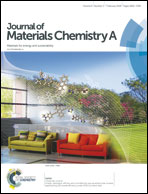High-yield bottom-up synthesis of 2D metal–organic frameworks and their derived ultrathin carbon nanosheets for energy storage†
Abstract
Two-dimensional (2D) metal–organic frameworks (MOFs) have been considered as promising precursors for the synthesis of 2D carbon materials for energy storage. However, the high costs and low yields of the synthetic methods for 2D MOFs are major obstacles for the preparation of 2D carbon materials from 2D MOFs. Herein, we report a facile and low-cost bottom-up synthesis of ultrathin Zn(bim)(OAc) MOF nanosheets (with a thickness of ∼5 nm and a high yield of ∼65%) and their derived N-doped porous ultrathin (2.5 ± 0.8 nm) carbon nanosheets (UT-CNSs) for energy storage. The UT-CNSs exhibit a capacitance of 278 F g−1 at a high current density of 10 A g−1, which is the highest among the reported MOF-derived carbon materials for supercapacitor electrodes. In addition, the UT-CNSs also exhibit a high reversible capacity of 553 mA h g−1 at 10 A g−1 and retain 100% coulombic efficiency after 1000 cycles at 2 A g−1 as an anode material for lithium ion batteries. The superior electrochemical properties of the UT-CNSs, especially at high current densities, are mainly due to their ultrathin morphology, large specific surface area, high conductivity, and suitable porous structure. This work provides a new strategy for the high-yield and low-cost synthesis of ultrathin MOF nanosheets as well as 2D carbon materials and their metal or metal oxide composites for various applications.

- This article is part of the themed collection: International Year of the Periodic Table: Elements for Next Generation Batteries


 Please wait while we load your content...
Please wait while we load your content...